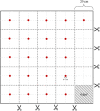Water-related atmospheric agents and solubility: two parameters of validation in toxicological screening on clothing worn by skeletal remains
- PMID: 37046051
- PMCID: PMC10247832
- DOI: 10.1007/s00414-023-02997-0
Water-related atmospheric agents and solubility: two parameters of validation in toxicological screening on clothing worn by skeletal remains
Abstract
In forensic toxicology, when conventional matrices are no longer available, alternative matrices can be used to assess toxicological investigations. Clothes worn by skeletal remains may be a good unconventional matrix for toxicological analyses considering that they have absorbed decomposition fluids and blood from a body. We hypothesized a scenario in which a skeleton, wearing clothes, was discovered in an open environment. From this starting point, an experimental study was developed on different textiles (cotton, wool, and polyester) to evaluate whether water-related atmospheric agents and molecule solubility can largely influence the detection of molecules of toxicological interest on this specific matrix, together with the characteristics of different garments chosen. The experimental study was performed on blood spots, previously spiked with 6-monoacetylmorphine and morphine, accurately placed on different textiles and washed with different quantities of deionized water adjusted at pH 5.6 with formic acid to simulate different rainfall conditions. Toxicological analyses were performed via Solid-Phase Extraction and High-Performance Liquid Chromatography-Tandem Mass Spectrometry analyses (Thermo Scientific™ TSQ Fortis™ II Triple-Quadrupole Mass Spectrometer). From the experimental study morphine could not be detected on 100% cotton and 100% wool fabric after the passing of 500 mL of deionized water and in 100% synthetic polyester textile after washing with 250 mL of deionized water. In conclusion, when toxicological analyses are carried out on unconventional matrices as textiles worn by corpses exposed to different environmental conditions, it is of great importance, in using such substrates as evidence for the presence of molecules of toxicological interest, to evaluate chemical-physical characteristics of each analyte under investigation in order to correctly interpret the toxicological data obtained.
Keywords: Fabrics remains as toxicological matrix; Molecules solubility; Rainfall intensities; Rainfall simulation; Toxicological analyses on skeletal remains.
© 2023. The Author(s).
Conflict of interest statement
The authors declare that they have no conflict of interest.
Figures
Similar articles
-
Chemical investigation of biological trace evidence; toxicological screening of waste residues obtained from DNA extraction processes.Int J Legal Med. 2024 May;138(3):721-730. doi: 10.1007/s00414-023-03119-6. Epub 2023 Nov 16. Int J Legal Med. 2024. PMID: 37968478 Free PMC article.
-
The washing away of evidence: The effect of different washing treatments on body fluid identification and DNA profiling from stained clothing fabrics.J Forensic Leg Med. 2025 Jul;113:102893. doi: 10.1016/j.jflm.2025.102893. Epub 2025 May 9. J Forensic Leg Med. 2025. PMID: 40373487
-
Layering garments during rest and exercise in the cold (8°C): wearer responses and comparability with selected fabric properties.Ergonomics. 2014;57(2):271-81. doi: 10.1080/00140139.2013.869356. Epub 2013 Dec 20. Ergonomics. 2014. PMID: 24354777
-
Sun-protective clothing.J Cutan Med Surg. 1998 Jul;3(1):50-3. doi: 10.1177/120347549800300115. J Cutan Med Surg. 1998. PMID: 9677262 Review.
-
Melding Vapor-Phase Organic Chemistry and Textile Manufacturing To Produce Wearable Electronics.Acc Chem Res. 2018 Apr 17;51(4):850-859. doi: 10.1021/acs.accounts.7b00604. Epub 2018 Mar 9. Acc Chem Res. 2018. PMID: 29521501 Review.
References
-
- Giordano G, Biehler-Gomez L, Seneci P et al (2021) Detecting drugs in dry bone : a pilot study of skeletal remains with a post-mortem interval over 23 years. Int J Legal Med :19–23. 10.1007/s00414-020-02494-8 - PubMed
-
- Franceschetti L, Di Candia D, Giordano G et al (2020) Drugs in bone: Detectability of substances of toxicological interest in different states of preservation. J Forensic Sci :1–10. 10.1111/1556-4029.14636 - PubMed



